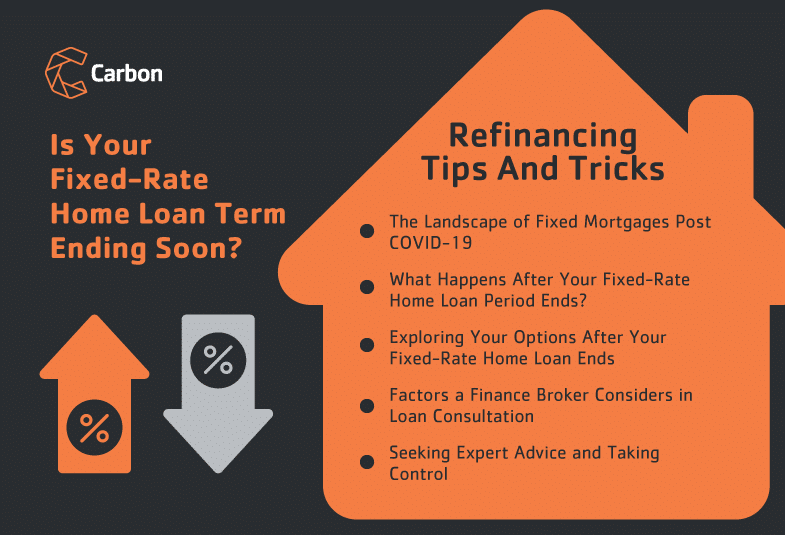If you are one of the almost 880,000 households to have a fixed loan expire in 2023, you may be wondering what your next move is once your fixed loan becomes a variable loan.
Table of Contents
The Landscape of Fixed Mortgages Post COVID-19
The decision to fix mortgage interest rates in the past few years since the COVID-19 pandemic has proved to be a smart decision for many households, delivering savings in the thousands or tens of thousands of dollars.
The Reserve Bank of Australia (RBA) announced earlier this month (Tuesday 1 August) that they would hit the pause button on the cash rate for the second month in a row, signalling we may be nearing or currently at the peak of interest rates following an enormous 4% climb in the cash rate from 0.10% to 4.10% over just a 14-month period from April 2022 to June 2023.
What Happens After Your Fixed-Rate Home Loan Period Ends?
Typically, once your fixed home loan date finishes, you will automatically default to your bank’s variable interest rate, which may not necessarily be the best option for you. Either the default variable rate will be quite high (6.5% and above) and you will be paying higher interest costs than if you shopped around, or your bank might not give you the information you need to save on interest costs (bank accounts with an offset feature). You will also have the option to fix your interest rate again, however it is best to get advice before jumping into a fixed loan again.
Your first port of call before (or even after) your fixed rate expires is to contact your finance broker. Banks have been increasingly competitive for new business, with some even offering cashbacks for your refinance. Your broker will be able to find the best option that suits your needs and make an informed comparison between banks and offers.
Exploring Your Options After Your Fixed-Rate Home Loan Ends
Your options after your fixed-rate home loan ends are typically the below:
1. Defaulting to the Variable Rate with Your Current Bank
This transition will automatically happen the day after your fixed rate expires. Given the current economic environment, it’s possible your new variable rate could be much higher than your previous fixed rate. This means your minimum repayments and interest charges may increase significantly (in some cases a minimum repayment per week/month will double).
2. Entering into a New Fixed Rate with Your Current Bank
Depending on the term you choose, which can range from 1 to 5 years, the current fixed rate offerings range between 6-7%. This is notably higher than the 2-4% seen in the last few years. Remember that if you have accumulated savings most banks do not allow a fixed rate mortgage to be offset by a savings balance/transaction account balance.
3. Refinancing to a New Bank
Moving to a different bank can offer you benefits in the form of lower interest rates or enticing cashback offers. With rates constantly evolving and banks competing for business, it’s worth considering refinancing, especially if another lender provides a more appealing package than your current one.
4. Splitting Your Loan
One innovative strategy involves dividing your loan into portions – some parts would have a variable rate, while others would be fixed. This option can be ideal for those with extra cash on hand; they can offset the mortgage with the variable portion, while still relishing the stability offered by the fixed rate portion.
Factors a Finance Broker Considers in Loan Consultation
Each set of circumstances is different and a finance broker can assess your whole situation so that your loan structure aligns with your overall financial goals, as well as minimising interest as much as possible. Some of the many variables that a broker will consider when looking at your best options are:
- Interest rate
- Fees and charges
- Where your other debt is held (business or personal/credit card)
- Offset account availability
- Which bank has the most ideal lending guidelines/serviceability that will suit your situation (some banks are easier than others for business owners/sole traders/contractors etc. OR for different industries)
- Customer service level of a bank/ease of conducting business, and
- Current wait times of each bank (some can blow out to a 6 week wait until they even look at your application).
Your finance broker will assist in finding and recommending a solution based on the criteria above and other factors. A broker will also provide impartial and unbiased advice to you based on their experience with a wide range of banks, compared to going to your bank directly, whereby a bank employee will only be able to detail their own product offerings to you.
Seeking Expert Advice and Taking Control
If your default variable rate seems high, or you just want to talk about refinancing or your loan structure, reach out to Carbon Finance & Lending for a free initial consultation and take control of your debt.
Have more questions about refinancing?
3 of Australia’s big 4 banks have lowered the mortgage serviceability test for refinancing meaning the home loan stress test has been reduced from 3% to 1%. That percentage is a buffer to prevent high risk lending from borrowers who can’t afford the steep rate. Carbon’s Accounting & Tax Partner, Michelle Maynard, sits down with Channel 9 to discuss what this means.






















